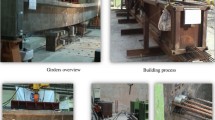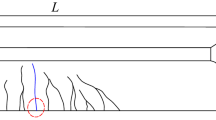Abstract
The objective of this paper is to perform the reliability analysis of stresses in prestressed concrete girders and development of design criteria for serviceability limit state design. Limit state functions for Serviceability Limit State (SLS) for compressive and tensile stresses at initial and service load stages are formulated based on fundamental design principles in the code. To establish statistical characteristics of concrete tension strength, two kinds of cylinder test, splitting tension tests and bending tension tests are performed for various specified strength of concrete. Other statistical characteristics for other variables such as live load, prestress forces, girder dimensions, and etc. are collected from related studies and references. Reliability indices are calculated for actually designed section and minimum section conformed with design requirement of typical prestressed concrete I-shaped girder and box type girder using first-order reliability method. Results are compared with reliability level of Ultimate Limit States (ULS) and target reliability indices of international standards. Finally, the live load factors in load combination for tensile stresses in prestressed concrete girder are proposed.
Similar content being viewed by others
References
AASHTO (1996). Design specifications for highway bridges, American Association of State Highway and Transportation Official, 4th Ed., Washington, D.C, USA.
AASHTO (2007). LRFD bridge design specifications, American Association of State Highway and Transportation Official, 4th Ed., Washington, D.C, USA.
Al-Harthy, A. S. and Frangopol, D. M. (1994). “Reliability assessment of prestressed concrete beams.” Journal of Structural Engineering, ASCE, Vol. 120, No. 1, pp. 180–199.
Eurocode (2004). EN 1992: Design of concrete structures.
Hewson, N. R. (2003). Prestressed concrete bridge, design and construction, Thomas Telford.
ISO (1998). ISO 2394: General principles on reliability for structures, International Standard Organization.
Joint Committee on Structural Safety (2000). Probabilistic model code, Part 1-Basis of Design, JCSS-OSTL/DIA/VROU-10-11-2000.
Kaewunruen, S. and Remennikov, A. M. (2008). “Reliability assessment of railway prestressed concrete sleepers.” Australian Structural Engineering Conference, ISBN: 978 1877040 70 2.
KBRC (2008a). Final report, Korea Bridge Design and Research Center.
KBRC (2008b). Proposed bridge design code by load and resistance factor design, Korea Bridge Design and Research Center.
Kim, J.-S. and Shin, J.-H. (2009). “Mechanical properties of concrete with statistical variations.” Journal of the Korea Concrete Institute, Vol. 21, No. 6, pp. 789–796, December.
Mirza, S. A. (1996). “Reliability-based design of reinforced concrete columns.” Structural Safety, Vol. 18, Nos. 2–3, pp. 179–194.
MLTM (2005). Korean bridge design code, Ministry of Land, Transportation and Marine Affairs, Korea.
Nawy, E. G. (2006). Prestressed concrete, a fundamental approach, Prentice Hall.
Nguyen, S. H. (2010). Reliability Analysis for serviceability limit state in prestressed concrete bridge girders, MSc Thesis, Kyung Hee University, Yongin, Korea.
Nowak, A. S. (1999). Calibration of LRFD bridge design code, NCHRP Report 368, Transportation Research Board, Washington, DC, USA.
Nowak, A. S. and Collins, K. R. (2000). Reliability of Structures, Mc Craw Hill.
Nowak, A. S. and El-Hor, H. H. (1995). “Serviceability criteria for prestressed concrete bridge girders.” Transportation Research Board, Vol. 2, pp. 181–187.
Nowak, A. S. and Szersen, M. M. (2008). Reliability-based calibration for structural concrete, Phase 3, PCA R&D Serial No. 2849.
Nowak, A. S. (2004). “System reliability models for bridge structures.” Bulletin of The Polish Academy of Sciences Technical Sciences, Vol. 52, No. 4, pp. 321–328.
Paik, I. Y., Hwang, E. S., and Shin, S. B. (2009). “Reliability of concrete bridges designed with material and member resistance factors.” Computers and Concrete, Vol. 6, No. 1, pp. 59–78.
Rackwitz, R. and Fiessler, B. (1978). “Structural reliability under combined random load sequences.” Computer and Structures, Vol. 9, No. 5, pp. 489–494.
Author information
Authors and Affiliations
Corresponding author
Rights and permissions
About this article
Cite this article
Hwang, ES., Nguyen, S.H. & Nguyen, Q.H. Development of serviceability limit state design criteria for stresses in prestressed concrete girders. KSCE J Civ Eng 18, 2143–2152 (2014). https://doi.org/10.1007/s12205-014-1426-x
Received:
Accepted:
Published:
Issue Date:
DOI: https://doi.org/10.1007/s12205-014-1426-x




